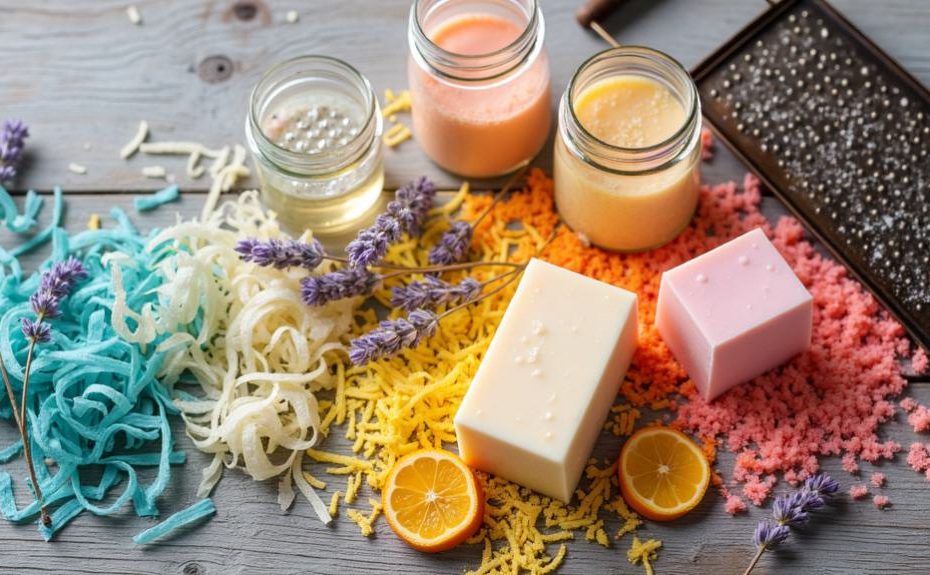I’ve found that recycling soap isn’t just about being thrifty – it’s a creative opportunity to reduce waste and discover multiple uses around your home. Start by collecting dry soap scraps in an airtight container, then melt them using a double boiler or microwave in short bursts. You can mold these into new bars with natural additives like essential oils or oatmeal, or repurpose them in surprising ways: lubricating squeaky hinges, creating natural pest deterrents in your garden, or even making your own laundry detergent. There’s so much more you can do with those humble soap scraps than you might imagine.
Collecting and Storing Soap Scraps
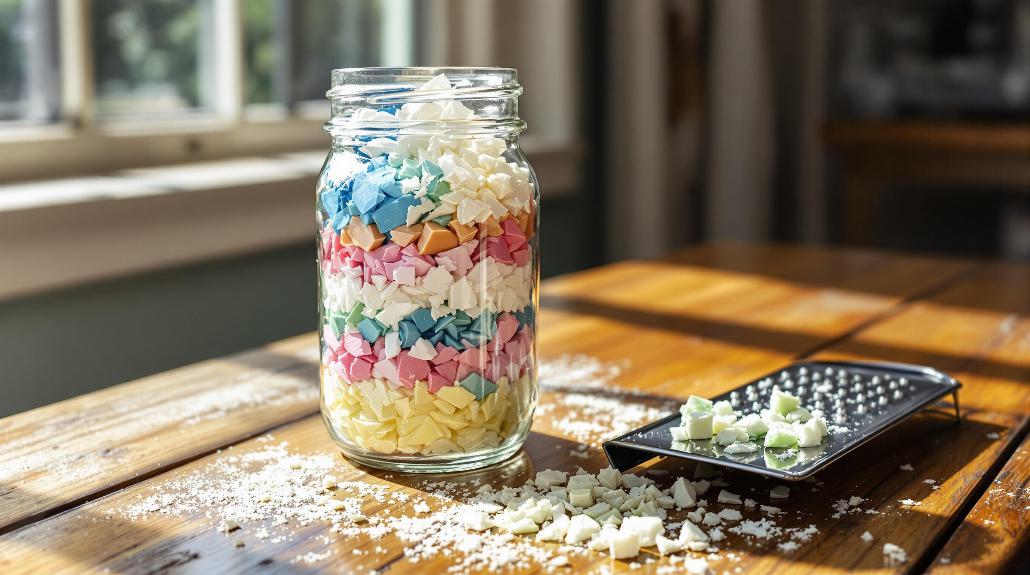
Looking back on my experience with recycling soap, I’ve found that collecting and storing soap scraps is the essential first step toward successful soap recycling. I’ve learned that keeping these precious bits from going to waste isn’t just economical – it’s surprisingly satisfying!
I always make sure to store my soap scraps in an airtight container, and here’s a pro tip: let them dry completely before storage, or you’ll end up with a moldy mess. I collect scraps from everywhere – home, hotels (yes, those tiny soaps count!), and even from friends who know about my recycling mission. I aim to collect about twenty soap slivers before starting the melting process.
For storage, I use a dedicated plastic container with a tight-fitting lid. I’ve labeled it “Soap Scraps” to avoid any bathroom confusion!
To keep things organized, I sort my scraps by type and break larger pieces into smaller chunks. Sometimes I’ll use a grater to shred them, which makes melting easier later on. I’ve also discovered that mesh bags and soap saver pouches work great for storing and using smaller pieces. They allow air circulation while keeping the scraps together and ready for their second life.
Melting Soap the Right Way
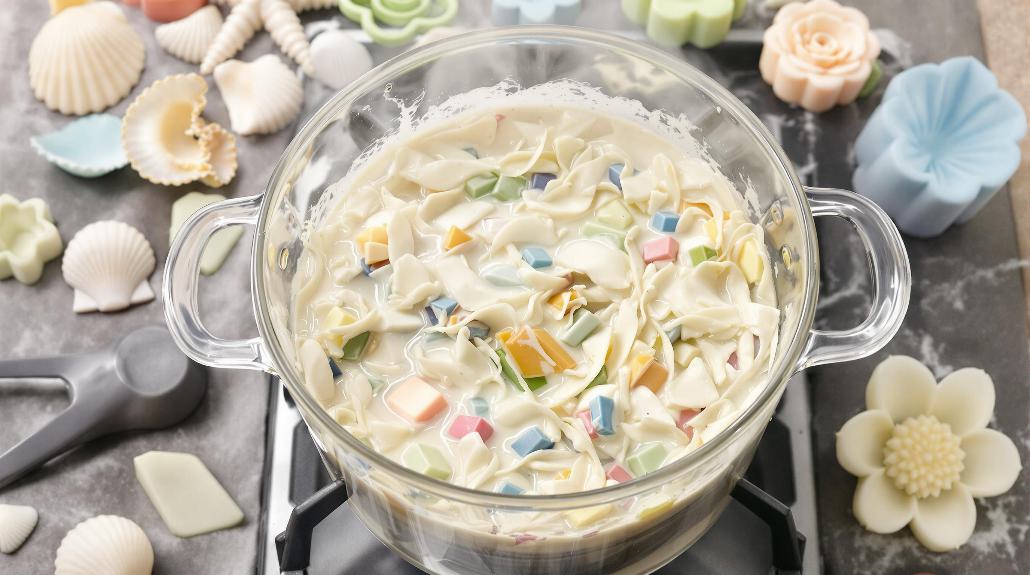
Now that you’ve gathered your soap scraps, it’s time to master the art of melting them safely and effectively. I’ll show you the best tools and techniques I’ve learned through experience.
I always start by cutting my soap scraps into small cubes – this helps them melt more evenly. You’ll need either a microwave-safe glass container or a double boiler setup. I prefer using a double boiler because it gives me more control, but both methods work well.
When using the microwave, I heat the soap in 20-30 second bursts, stirring between each interval. Temperature control is essential – I keep my soap between 120-135°F using a thermometer. Trust me, you don’t want to overheat it! I’ve learned the hard way that boiling soap isn’t pretty. Using an infrared thermometer is ideal for getting accurate readings.
Keep stirring constantly while adding just a tiny bit of water if needed. Don’t forget your safety gear – I always wear gloves and make sure my workspace is well-ventilated.
Once you’ve got the hang of it, you can experiment with different pouring temperatures to create beautiful swirls and patterns in your recycled soap. Just remember to keep children and pets away from your work area.
Making New Soap Bars
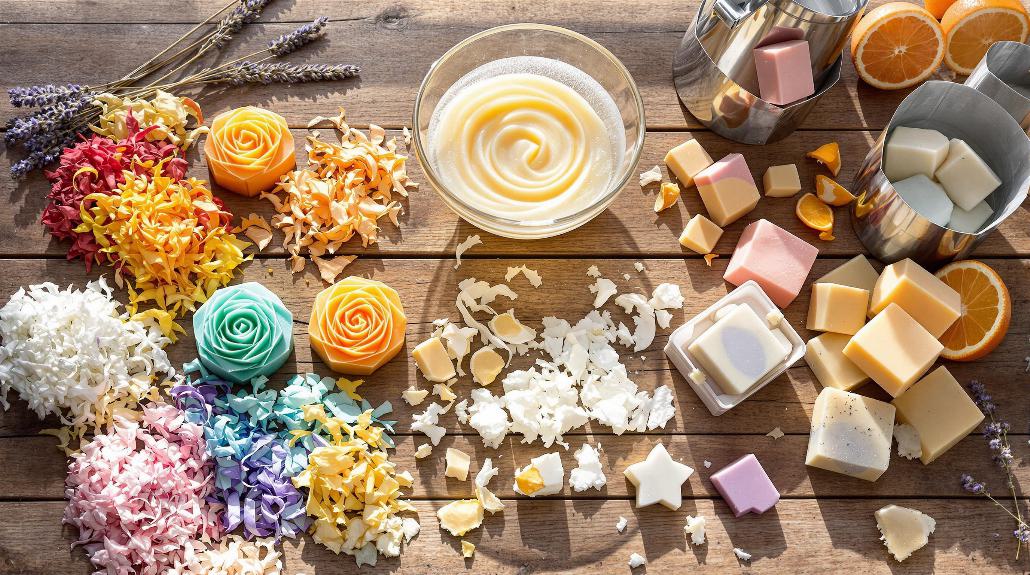
Creating new soap bars from melted scraps requires patience and attention to detail. Once you’ve got your melted soap mixture ready, it’s time to transform it into fresh, usable bars.
I like to prepare my molds by giving them a light coating of grease to prevent sticking – trust me, you don’t want your new soap stuck in the mold!
Using a technique similar to a drop swirl pattern, you can create beautiful designs in your recycled soap.
Here are my favorite ways to make your recycled soap bars special:
- Add a few drops of essential oils just before pouring for a custom scent
- Use a wire to create swirl patterns in the liquid soap
- Experiment with different mold shapes for unique designs
Pour your melted mixture carefully into the molds, making sure to catch any drips – these can actually be added back in for a fluffier texture.
I’ve found that letting the soap set overnight in the refrigerator works best. After that, you’ll want to let your new bars dry for about a week. This drying time is vital; it helps the bars last longer and perform better.
If you’re using mixed soap scraps, you might end up with an interesting marbled effect that makes each bar unique!
Natural Soap Additives
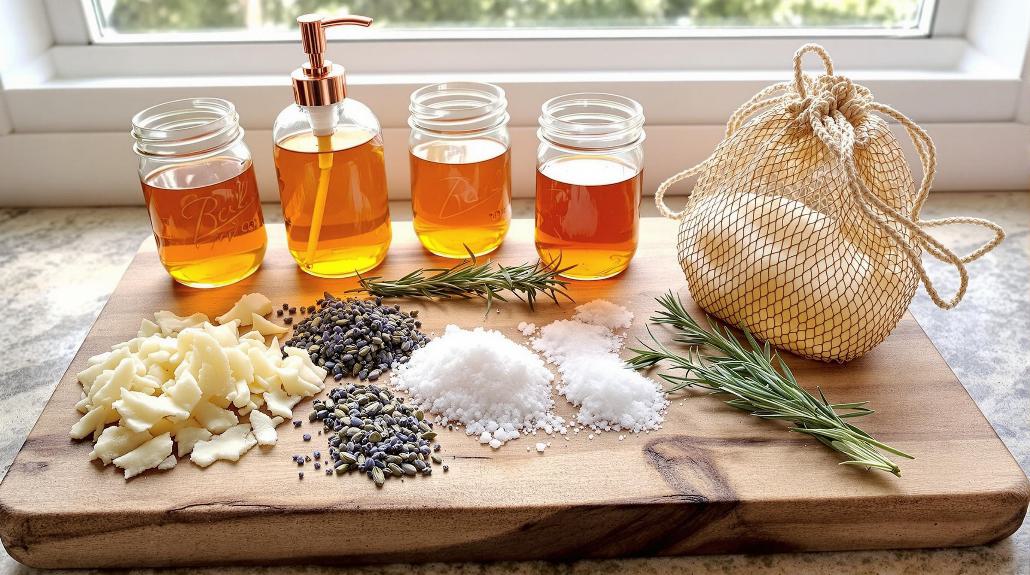
With your recycled soap bars ready for enhancement, natural additives can transform them into luxurious, skin-nourishing creations.
I love using ingredients like turmeric and alkanet powder to add beautiful natural colors, while purple Brazilian clay brings both color and beneficial minerals to the mix.
For texture and hardness, I’ve found that kaolin clay works wonders in creating a silky feel, while a touch of salt or beeswax helps your bars last longer.
Here’s a fun tip: adding coconut milk not only makes your soap creamy but also gives it amazing cleansing properties.
Want to add some gentle exfoliation? I recommend colloidal oatmeal – it’s fantastic for soothing irritated skin while providing a subtle scrub.
Sugar’s another great option that’ll boost your soap’s lather while it exfoliates.
Don’t forget about fragrance! I always keep essential oils handy for natural scents, and a drizzle of raw honey adds both aroma and extra lather.
If you’re feeling fancy, try dissolving silk fibers in your mixture – though if you’re vegan, aloe vera liquid makes an excellent alternative for that luxurious feel.
Household Uses Beyond Washing
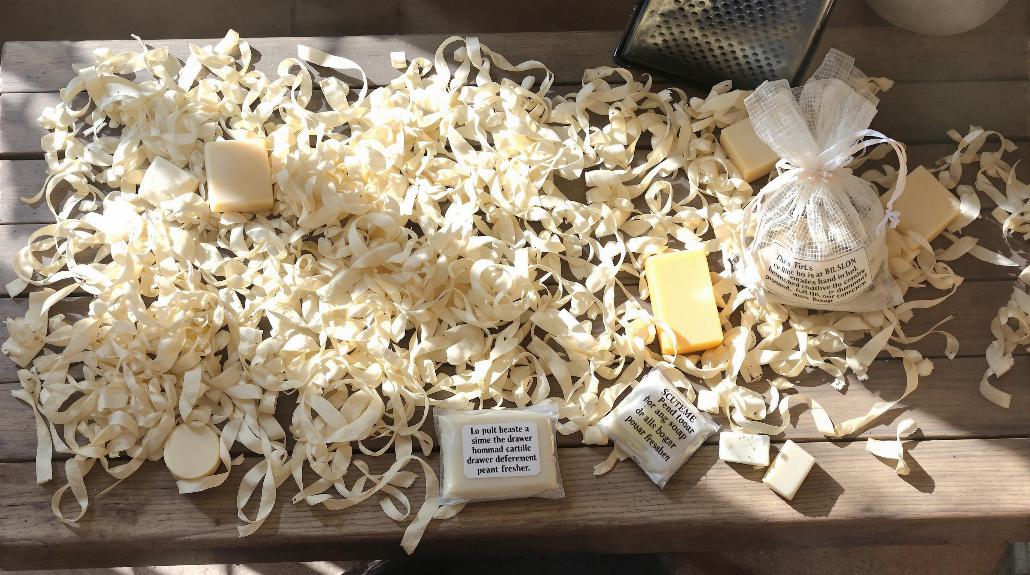
Recycled soap’s versatility extends far beyond the bathroom sink, offering dozens of practical household solutions.
I’ve discovered some amazing ways to put soap to work around my home, and I’m excited to share these clever tricks with you. From fixing squeaky doors to protecting my garden-loving hands, soap has become my go-to solution for many household challenges.
Here are some of my favorite unexpected uses for soap that’ll make you see this humble bathroom staple in a whole new light:
- Rub it on door hinges to silence that annoying squeak (who needs WD-40?)
- Create an instant pin cushion by wrapping a bar in fabric – it’s perfect for keeping needles sharp
- Protect your fingernails while gardening by scratching them across a bar of soap first
I also love using soap for quick fixes around the house.
When I spot a nail hole in my wall, I simply fill it with soap and smooth it out. For stubborn stains on clothes, I’ve found that rubbing them with wet soap before washing works wonders.
And here’s a pro tip: I always keep a bar of soap in my dresser drawers to keep my clothes smelling fresh.
Garden and Outdoor Applications
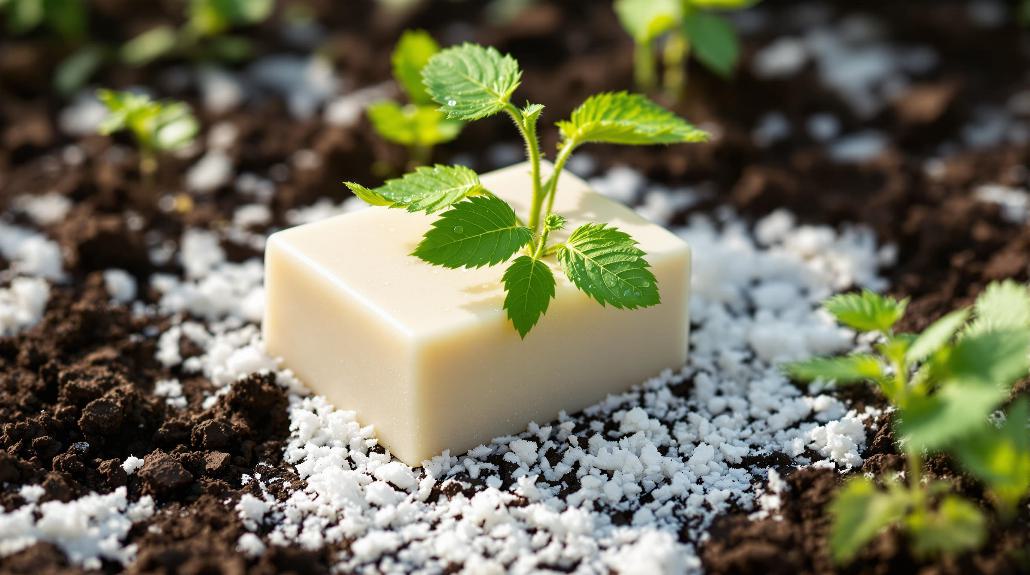
Soap’s mighty potential in the garden extends far beyond basic cleaning, offering eco-friendly solutions for pest control, weed management, and sustainable irrigation.
I’ve found that not all eco-friendly soaps work well in gardens though, so I’ll help you choose the right ones for your green space.
Let me share a fantastic weed-killing recipe I use: mix one ounce of biodegradable soap with a gallon of vinegar. Just be careful to aim directly at those pesky weeds – you don’t want to accidentally spray your prized petunias!
For pest control, I toss small pieces of biodegradable soap into my compost pile twice a year. It’s like giving unwanted bugs an eviction notice.
I’m particularly excited about greywater irrigation using compatible soaps, which has cut down my water usage considerably.
If you’re feeling creative, don’t toss those empty soap dispensers – they make surprisingly cute planters for succulents and microgreens.
Just remember to check your soil type first, especially if it’s alkaline, as some soaps can be a bit too harsh for sensitive garden beds.
Environmental Benefits of Soap Recycling
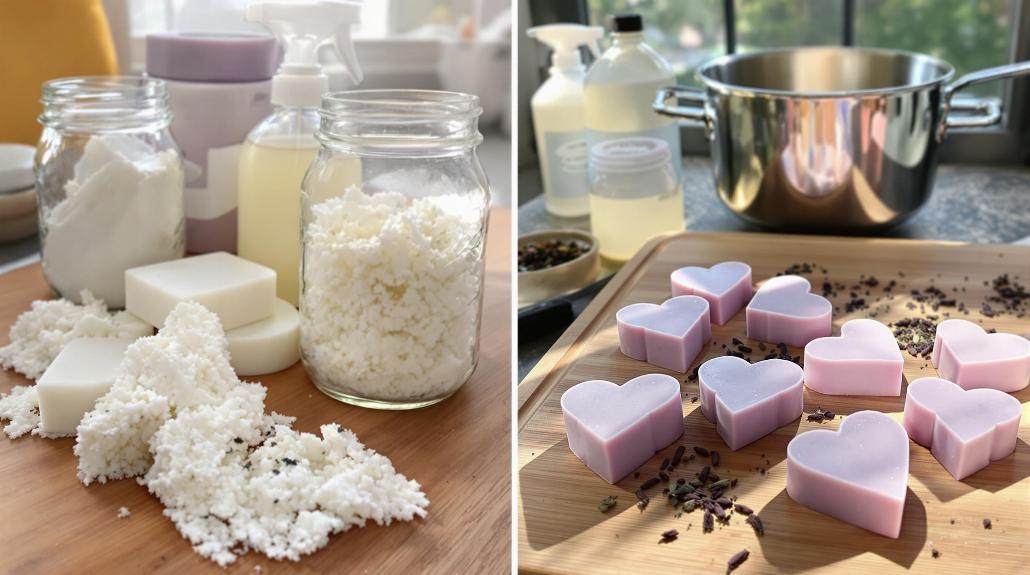
Beyond the garden gate, recycling soap creates ripples of positive environmental impact that stretch across our planet.
I’m excited to share how this simple act of recycling soap can make such a profound difference for our environment and communities worldwide.
When you choose to recycle soap, you’re contributing to a more sustainable future in several meaningful ways:
- You’re helping reduce landfill waste, as every bar of recycled soap means one less addition to our growing waste problem.
- You’re conserving energy and resources that would otherwise be used to produce new soap.
- You’re supporting a circular economy that turns “waste” into valuable resources for those in need.
I’ve seen firsthand how soap recycling programs are transforming the hospitality industry’s approach to sustainability.
Instead of tossing partially used bars, hotels are now partnering with organizations that collect, sanitize, and redistribute this soap to communities in need.
This process not only reduces our carbon footprint but also creates jobs and improves public health globally.
When you think about it, it’s amazing how something as simple as recycling soap can create such a powerful chain reaction of environmental and social benefits.
Frequently Asked Questions
Can I Mix Antibacterial and Non-Antibacterial Soap Scraps Together?
I wouldn’t recommend mixing antibacterial and non-antibacterial soap scraps together.
While it might seem practical, this combination can reduce the antibacterial soap’s effectiveness and potentially create unpredictable chemical reactions.
The different formulations don’t always play well together, and you might end up with a product that’s less effective than either soap on its own.
Instead, I’d suggest keeping your soap scraps separate.
How Long Does Recycled Soap Last Compared to Store-Bought Bars?
Let me break down the shelf life difference for you!
While store-bought bars typically last 2-3 years due to their added preservatives, recycled soap generally stays fresh for about a year.
I’ve found that recycled soap’s shorter lifespan isn’t a deal-breaker, though – it’s still perfectly usable, just keep it in a cool, dry place.
You might notice the scent fading sooner, but it’ll still get you squeaky clean!
Is Recycled Soap Safe to Use on Sensitive Skin?
Picture a gentle stream of clear water washing over your skin – that’s how recycled soap should feel.
I’ve found that recycled soap can be safe for sensitive skin, but it depends on the original ingredients and proper processing.
I’d recommend checking that it’s made from mild, plant-based ingredients and properly sanitized.
If you’re concerned, I suggest starting with a small patch test on your skin first.
Can I Add Essential Oils to Melted Soap Without Affecting Its Properties?
I recommend adding essential oils to melted soap, but you’ll need to follow specific guidelines to maintain its properties.
Keep the soap base temperature below the oil’s flashpoint, use proper measurements by weight (not drops), and stick to recommended usage rates.
I’ve found that stirring thoroughly helps distribute the oils evenly, while adding them at the right temperature guarantees they’ll retain their scent and beneficial properties.
Does Recycling Soap Affect Its Ability to Kill Germs and Bacteria?
You might be surprised to learn that recycled soap maintains its germ-fighting power!
I can tell you with confidence that when soap is properly recycled, it doesn’t lose its ability to remove germs and bacteria.
Here’s the fascinating part: soap doesn’t actually kill germs – it helps wash them away through its unique molecular structure.
Whether new or recycled, soap’s effectiveness stays intact as long as it’s processed correctly.
